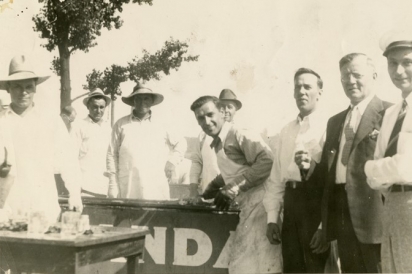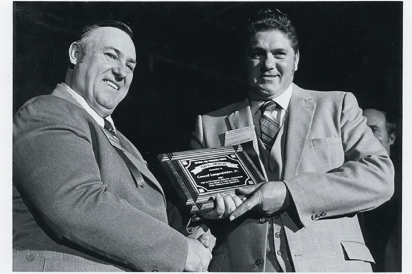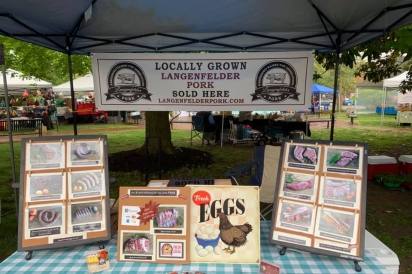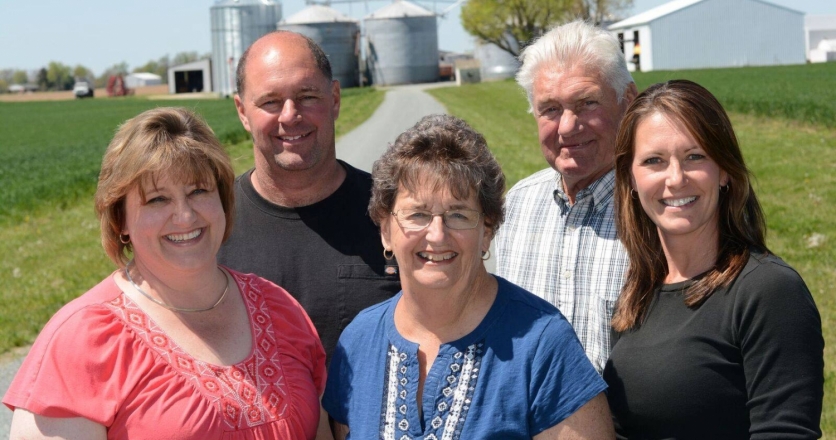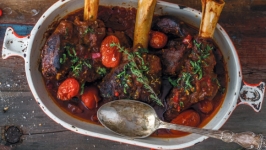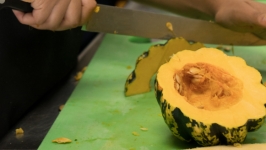Langenfelder Pork: Going Hog Wild on the Eastern Shore
PHOTOS BY THE LANGENFELDER FAMILY
A few days after Christmas, with a Maryland sky looming cloudy and gray, I packed up my car and prepared for the long drive back to Brooklyn after visiting family in Chestertown for the holidays. My partner and I drove north along US-301 as passing cars moved with extra caution, and I could see children sleeping in backseats among the piles of gift bags and still-wrapped presents. Though frost clung to the windshield and our breath steamed out in misty clouds, I kept the heat turned low and my speed reduced. For I too traveled with precious cargo in the back seat: a massive gift bag of pork products from Langenfelder Pork. My empty freezer at home would soon be stocked with thick cut bacon, maple sausage links, cheddar brats, Italian loose sausage, and a pork tenderloin. The next few weeks would be spent blissfully consuming pork for breakfast, lunch, and dinner. Never mind that the bag was insulated, and despite the pleas for warmth from the passenger seat, I wasn’t taking any chances.
I’m not the only person who can’t get enough of Langenfelder Pork, and I surely wasn’t the only roadrunner heading home from the holidays with a full cooler. It’s common to overhear patrons at the Chestertown Farmers Market praising the company or to see hyperbolic exclamations on social media about Langenfelder Pork being the best tasting pork around. Many local restaurants and chefs faithfully source Langenfelder Pork because of the high-quality meat and the local access to Langenfelder products, which cuts wasteful links along the supply chain.
Bill Schindler, who, along with his family, runs the ever-growing Modern Stone Age Kitchen in Chestertown, and who often uses nose to tail ingredients, sources a half hog from Langenfelder’s for his Italian-style Half Hog Hoagie. Bill makes mortadella, ham, capicola, and salami from Langenfelder hogs in the Modern Stone Age Kitchen, and it’s common for his mortadella to end up on Modern Stone Age Kitchen’s Friday pizza specials as well.
The home of Langenfelder Pork is Grand View Farm in Kennedyville, Maryland, where the Langenfelder family continues a longstanding tradition of farming and raising pigs. Kent County is home to many farmers and producers. According to the US Department of Agriculture, approximately 57%, or 102,251 acres, of Kent County is prime farmland. The USDA defines prime farmland as the land that is best suited to producing food, feed, forage, fiber and oilseed crops. Prime farmland produces the highest agricultural yields with the smallest amount of energy and economic input. Because of the excellent soil quality, the majority of farmland in Kent County is used to grow corn, soy, and grains, with less farmland being used for grazing. Like many local farms, the Langenfelder family also grows corn, soy, wheat, and barley, but it's their pork and its place in the local food scene that generates the most excitement.
The Delmarva Peninsula is a major producer of animals for consumption, but the region is largely dominated by poultry and is the fifth largest producer of poultry in the nation. In the 1920s, Delmarva was one of the first areas in the nation to produce broilers, chickens that are raised specifically for their meat. Five of the country's largest poultry companies – Tyson Foods, Perdue Farms, Mountaire Farms, Amick Farms, and Allen Harim Foods – all have plants in Delmarva. According to statistics from anthropologist Dr. Thurka Sangaramoorthy, the industry employs 21,000 workers, and consists of 2,800 contract growers, 10 feed mills, and 15 hatcheries. Clearly, this is not a small operation.
There are far fewer pork producers in the region than there are farmers growing grain or raising poultry. Jenell Eck McHenry, of the Maryland Pork Producers Associated, explained that Maryland ranked 30th out of the 50 U.S. states in the number of pigs marketed. With an annual average of 44,409 hogs from 2020-2022, Maryland ranked far behind the nation’s largest producer, Iowa, which produces an average of 33-40 million hogs, a term referring to a pig that has reached maturity and a weight of about 120 pounds.
The Langenfelders’ farming history dates back six generations to the 1840s when the family patriarch, John Langenfelder, emigrated from Germany to Baltimore County. Initially his land was used for a self-sustaining farm, where he grew vegetables and raised animals for his family’s consumption. During the Great Depression, fourth-generation Conrad Sr., began to sell hogs and meat to neighbors for extra income. Alongside his wife, Martha, Conrad sold homemade scrapple and sausage using an old family recipe. That sausage recipe, which I tried to pry open from the vaults of family’s secrecy, exists to this day.
The Langenfelder packaged pork is still a relatively new addition to the local marketplace, added in 2016. At that time, about half of the farm’s revenue was coming from their crops of corn, wheat, and soy, and half from the sale of feeder pigs and wholesale hogs that are sent to Sudlersville Meat Locker for local processing.
In the 2010s, prior to the establishment of the Langenfelder Pork brand, the farm-to-table movement began to rise in popularity. Restaurants started labeling their menu items with the name of the farms and producers from which their ingredients were sourced. Restaurants who purchased Langenfelder’s pork from Sudlersville Meat Locker unknowingly created a viral marketing campaign as the Langenfelder name began to grow. The demand was also felt by Sudlersville Meat Locker, whose customer base began to seek out Langenfelder pork by name. It was then that the family began building relationships with local farmer’s markets and family-run marketplaces to partner in selling their pork.
When I’m in town, I purchase Langenfelder Pork from the Chestertown Farmers Market or from Guernsey Depot in Chestertown. When the youngest generation of the family is home from college, they are present at the Farmers Market, but other local market options include Emily’s Produce in Cambridge, Twin Oak Farms in Stockton, Filmer’s Market in Delaware, among a growing number of family run shops. You can also order directly from the Langenfelder Pork website for local pickup.
Dutch and Pat Langenfelder, the family’s fifth generation, moved the farm to Kent County roughly thirty years ago. Their children, Jennifer, Bill, and Kristen have continued to run the operation today. The family are independent pork producers, which affords them greater flexibility with their business than contract growing would.
At home in Brooklyn, I crave the Langenfelder loose sausage and cheddar brats. I taste a gamier flavor to the sausage meat than pork purchased from my local big-chain grocery, and my pasta sauce, tacos, and stir-fries are better for it. When I met with Jennifer at the farm in Kennedyville, she explained that the unique flavor is due to an absence of sage, which features more prominently in other brands of sausage, which allows the true flavor of the pork to come through.
In terms of a secret ingredient to the family’s success or the taste of their pork, there is none. Their success comes from hard work, consistency, and a continuing drive from each successive generation to keep the family business running. Jennifer notes, “This is a 24/7/365 type of job. Even on Christmas Day, we open our presents, and then head out to check on the pigs.”
Despite the rise of farmer influencer culture, which is important to telling the story of growers but at times can make the profession seem easy, the reality is that farm work is hard, messy, and often unglamorous work. The Langenfelders have a large-scale operation with over 600 pigs at their farm. They run a “farrow to finish” operation, meaning that pigs are raised from birth until slaughter, which requires a knowledge and proficiency of raising the animals at different stages of life. Sows are moved to a nursery where they give birth to litters as large as fourteen piglets. Nursing piglets are often in a precarious position due to the sow’s massive size, so the piglets are monitored to ensure their safety. Assisting with births and ensuring the largest number of piglets can reach maturity guarantees your hands are going to get dirty.
Further adding to the reality of farm life, the hogs’ manure is repurposed as fertilizer for the farm’s crops, and that task doesn’t happen without human labor. Farmers like the Langenfelders know the realities of life, death, all manner of smells and sounds, and the daily grind of a job where you never officially clock out.
Surprising to me were the technological advancements involved in raising hogs, such as electronic sow feeding. This is an automated feeding system with sensors on the tagged sows that controls their daily feed intake. I observed the hogs feeding while a chorus of grunts and squeals echoed like a concert at Red Rocks. As massive sows dined on the family’s homegrown grain, Jennifer pointed out different hogs and told me about their characteristics: who asserts their dominance and who is more ornery than others.
Kent County has not been immune to the challenges of nationwide labor shortages. Fortunately for the Langenfelders, Jennifer, Bill, and Kristin have seven children between them and this youngest generation have already committed to running the family brand in the future. Bill’s daughters Lexi and Kendall run the Langenfelder booth at the farmer’s market when they are home from college during summer break. Jennifer’s son Drew works for the family business full time, while her sons Mark and Mitch, as well as Kristen’s sons Dutch and Michael, help with planting and harvesting during the busy season.
For residents of Kent County and the wider Delmarva Peninsula, be thankful that you don’t need to travel far to get the best pork around. For me, I’m just happy knowing that regularly stocking up on my favorite local pork during visits to the Eastern Shore will continue for many years to come.
Langenfelder Pork and Grand View Farm
11974 Black’s Station Road, Kennedyville, MD
Facebook




